August 8 2005
We’re nearing Stockholm, on what Carolyn described as our “soldiers in the army” approach.

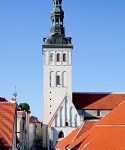 After the wondrous medieval city of Tallinn (joke–named after the soviet leader from the 40s), which included the tallest building in the world–circa 1600, naturally a church–we came to the imperial city of the Russian Czars.
After the wondrous medieval city of Tallinn (joke–named after the soviet leader from the 40s), which included the tallest building in the world–circa 1600, naturally a church–we came to the imperial city of the Russian Czars.
Though I’ve been to St. Petersburg before, I’m still in awe of the wealth the Czars had. So much that even though I had been here before, we saw only one place I’d been to! One of the palaces was built by Peter I because it was halfway between the city and the naval base. I would love to be
much that even though I had been here before, we saw only one place I’d been to! One of the palaces was built by Peter I because it was halfway between the city and the naval base. I would love to be  able to say, “build me a castle here, spend anything you wanted, and outdo the French.” The architect succeeded in all counts. The Hermitage is similar—built as a palace, then as a house for the extensive artwork purchased or pilfered by the Czars and later the Soviets, it’s an awesome place, full of paintings and people.
able to say, “build me a castle here, spend anything you wanted, and outdo the French.” The architect succeeded in all counts. The Hermitage is similar—built as a palace, then as a house for the extensive artwork purchased or pilfered by the Czars and later the Soviets, it’s an awesome place, full of paintings and people.  When we had our free time (if it’s 2:00, we must be in the Rembrandt room!), I wandered into the Asian art, which I had to myself. There were murals ripped from the walls of caves Dave and I had visited in central Asia, and Indian sculptures that “were in the Berlin museum until 1945”)! Wondrous stuff indeed, but so ostentatious one wonders why the Russian peasants tolerated it until 1917! St. Petersburg seems much busier and seemingly more prosperous than I remembered, but we have had little contact with locals other than guides, and guides represent the chamber of commerce!
When we had our free time (if it’s 2:00, we must be in the Rembrandt room!), I wandered into the Asian art, which I had to myself. There were murals ripped from the walls of caves Dave and I had visited in central Asia, and Indian sculptures that “were in the Berlin museum until 1945”)! Wondrous stuff indeed, but so ostentatious one wonders why the Russian peasants tolerated it until 1917! St. Petersburg seems much busier and seemingly more prosperous than I remembered, but we have had little contact with locals other than guides, and guides represent the chamber of commerce!
We went to a folklore dance in one of the former grand duke palaces, which featured Cossacks, I (along with several of the other Jews aboard—the record of antisemitism in the Baltics isn’t confined to the Nazis–whispered to Carolyn, “These are the folks who convinced my Dad’s family to flee to the US”).

Yesterday, we stopped in Helsinki, and I have to admit we had little to prepare us for it. Almost, “Oh, are we going there?” Again, a wonderful surprise–neither medieval nor majestic, but full of neat architecture, and–for the first time on the trip, an opportunity to wander aimlessly (the downside of the tour trips!). I had reindeer for lunch, and I hope Rudolph will not hold it against me for Christmas. Cause I’ve been behaving–hard as it might be! The Scandinavian countries (north side of the Baltic plus Denmark) are among the richest countries in the world, though the populations are really small–under 5 million.
 Great trip, full of mediaeval and majestic–St. Petersburg is full of the lavish wealth of Russia, all squandered by the Tsars on themselves, while most of the other cities spent time between Sweden and Denmark in the early period, then the Knights, then Sweden/Poland, and finally Germany/Russia. Saw a wonderful performance in St Pete by Cossacks, the same wonderful folks who helped me be an American.
Great trip, full of mediaeval and majestic–St. Petersburg is full of the lavish wealth of Russia, all squandered by the Tsars on themselves, while most of the other cities spent time between Sweden and Denmark in the early period, then the Knights, then Sweden/Poland, and finally Germany/Russia. Saw a wonderful performance in St Pete by Cossacks, the same wonderful folks who helped me be an American.
One revelation occurred at the Amber Room of the Catherine Palace in  Tsarskoye Selo. The panels for the room were gifted to Catherine by Frederick of Prussia, and vanished during Nazi occupation. Ironically, the room, symbol of Russia, was one of the first items Stalin rebuilt–Stalin being the exemplar of world-wide communism!
Tsarskoye Selo. The panels for the room were gifted to Catherine by Frederick of Prussia, and vanished during Nazi occupation. Ironically, the room, symbol of Russia, was one of the first items Stalin rebuilt–Stalin being the exemplar of world-wide communism!
Helsinki was a treat, but these northern Scandinavian countries are wealthy!
One thing they never warned us about: the Baltic is a shallow sea, so when it gets stormy, it rocks. I remember reading, “The World is Flat,” in a storm, and was ready to challenge Thomas Friedman’s title as the ship tilted and drawers opened and closed.
Carolyn has described our shore time as “soldiers,” but it’s been a great pace on shore, and kind of fun aboard–especially doing yoga on the foredeck! Not enough time for me to wander aimlessly, though!








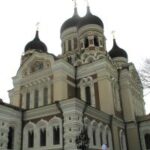









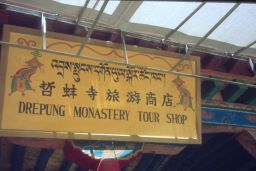



 e is amonument to the 16th century treaty by which the Ming emperor defined relations with the Dalai Lama as uncle/nephew. In the 1950s, China “liberated” Tibet, which is why there is a huge monument in Lhasa, and not always subtle reminders that China is the dominant power in the region. Our guide, who is of Tibetan nationality, told us he had to be careful in public because there were spies everywhere. Since riots in 1989, the government has been wary of Tibetan Buddhism, taking over festivals and controlling the monasteries.
e is amonument to the 16th century treaty by which the Ming emperor defined relations with the Dalai Lama as uncle/nephew. In the 1950s, China “liberated” Tibet, which is why there is a huge monument in Lhasa, and not always subtle reminders that China is the dominant power in the region. Our guide, who is of Tibetan nationality, told us he had to be careful in public because there were spies everywhere. Since riots in 1989, the government has been wary of Tibetan Buddhism, taking over festivals and controlling the monasteries.
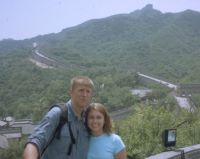

 awe when I’m in what the Chinese think of the center of the Universe.
awe when I’m in what the Chinese think of the center of the Universe.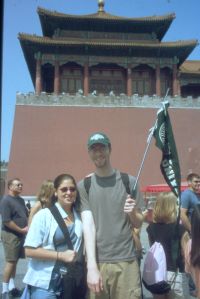
 That began another day of taking students to things they had only seen on TV and dreamed about doing. We went to the Great Wall, which stretches over 3000 miles from central Asia to the Gulf of Petchili, and passes about 50 miles north of Beijing. I remember the first time I went on a two-lane road–weaving among the horse carts. Today it is a superhighway.
That began another day of taking students to things they had only seen on TV and dreamed about doing. We went to the Great Wall, which stretches over 3000 miles from central Asia to the Gulf of Petchili, and passes about 50 miles north of Beijing. I remember the first time I went on a two-lane road–weaving among the horse carts. Today it is a superhighway. stretches of it. I took the class to Badaling, which has the most people and the pushiest vendors–that is part of the experience. We climbed over 680 feet, and I realized that the first emperor and his successors had been wise in building the wall because, while it never kept the barbarians out (or the Chinese in), it is a great tourist attraction!
stretches of it. I took the class to Badaling, which has the most people and the pushiest vendors–that is part of the experience. We climbed over 680 feet, and I realized that the first emperor and his successors had been wise in building the wall because, while it never kept the barbarians out (or the Chinese in), it is a great tourist attraction! The other highlight in that area is the tombs of the Ming emperors. You have seen pictures of the stone animals that guard the valley; if you haven’t I may show you mine, and some of you will get postcards of them.
The other highlight in that area is the tombs of the Ming emperors. You have seen pictures of the stone animals that guard the valley; if you haven’t I may show you mine, and some of you will get postcards of them.



 others are as excited about the potential for Asia (especially China) economically as you read about in the paper. The Chase researcher was really harried because he had worked with the revaluation to the dollar peg here for the past few days.
others are as excited about the potential for Asia (especially China) economically as you read about in the paper. The Chase researcher was really harried because he had worked with the revaluation to the dollar peg here for the past few days. sometimes like IWU and Millikin, or better , Troop 19 and the world!
sometimes like IWU and Millikin, or better , Troop 19 and the world! penalty here); instead, we had a customs inspection, followed by a return to the train which took us to downtown Singapore to our hotel.
penalty here); instead, we had a customs inspection, followed by a return to the train which took us to downtown Singapore to our hotel. It is an important city in history, and we went to part of it yesterday; in 1942, the impregnable fortress at Singapore fell to the Japanese despite having the reputation for being the bastion of Western supremacy in Asia. The Japanese did what we did–they came down the peninsula from the landside, and most of the guns were trained on the sea. Western supremacy never recovered. We explored an old fort as part of our visit, and it had a moving history of Singapore under Japanese domination. They punished the local Chinese for supporting Chiang Kai-shek by putting them on barges and throwing them in the ocean.
It is an important city in history, and we went to part of it yesterday; in 1942, the impregnable fortress at Singapore fell to the Japanese despite having the reputation for being the bastion of Western supremacy in Asia. The Japanese did what we did–they came down the peninsula from the landside, and most of the guns were trained on the sea. Western supremacy never recovered. We explored an old fort as part of our visit, and it had a moving history of Singapore under Japanese domination. They punished the local Chinese for supporting Chiang Kai-shek by putting them on barges and throwing them in the ocean.